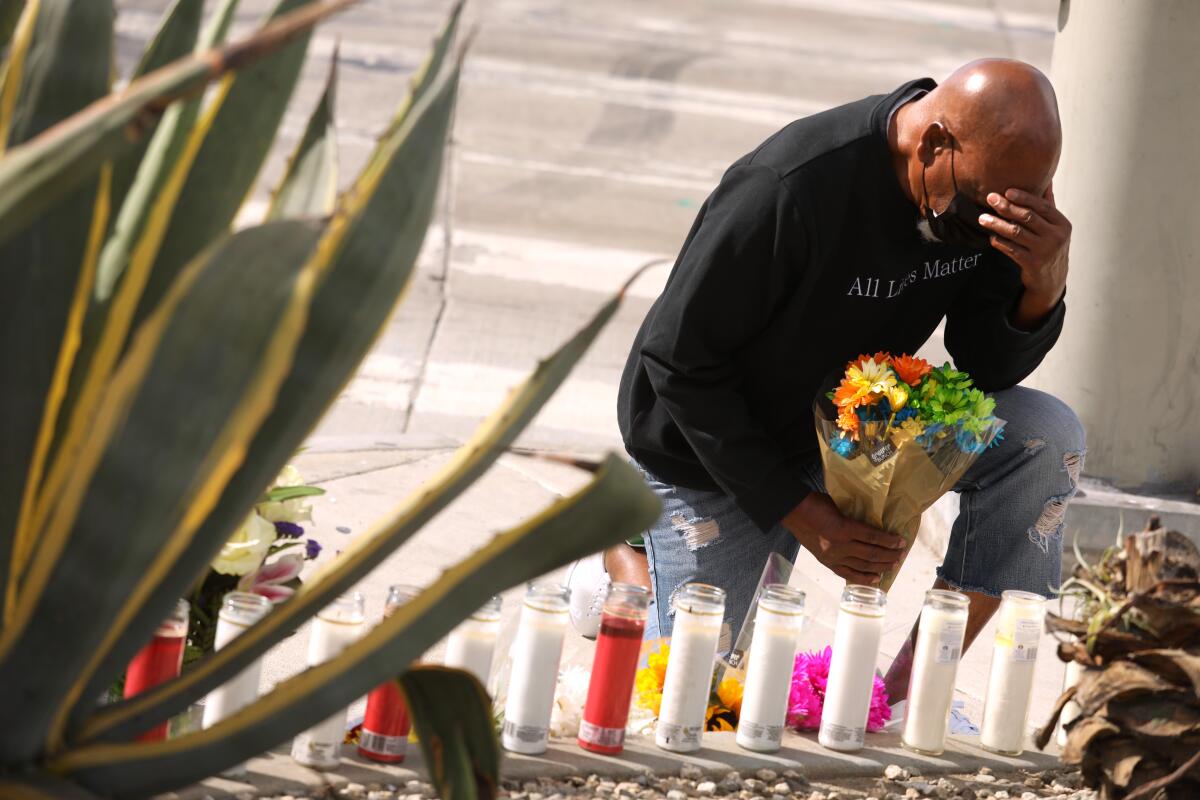Voters could help fix L.A.’s deadly streets

- Share via
Good morning. I’m Kerry Cavanaugh, assistant editorial page editor, filling in for Paul Thornton, who is taking a week off. It is Saturday, Aug. 13. Let’s look back at the week in Opinion.
It’s been a little more than a week, but the wreckage and horror from a fiery fatal crash in Windsor Hills is still on my mind. Five people, including a woman 8½ months pregnant, were killed when a motorist in a Mercedes-Benz sedan speeding 90 mph blew through a red light and plowed into several cars. Vehicles burst into flames. Billowing smoke could be seen from miles away. The victims were just driving across town, running errands or heading to the doctor’s office, and their lives were snuffed out in an instant.
We talk a lot about gun violence in this country — as well we should — but almost as many people were killed by motor vehicles as by firearms in 2020. Cars have become significantly safer for drivers and their passengers, with air bags, seat belts and all kinds of crash-impact protections, yet traffic deaths are on the rise. Nearly 43,000 people died in motor vehicle crashes in 2021, a 10.5% increase over the prior year.
Speeding, reckless driving, inattention and driving while intoxicated are to blame. And so is our infrastructure, particularly in Los Angeles. The streets are dangerous by design, as letter writers observed. Just look at the intersection of Slauson and La Brea avenues in Windsor Hills, where the crash happened. The wide, seven-lane roads are designed to move cars as quickly as possible. And these kinds of streets — highways, really — are all over Los Angeles communities because for decades the goal of transportation planning was to build fast, free-flowing roads for the convenience and speed of drivers. Good luck to pedestrians and bicyclists.
There is a movement to stop the carnage. Earlier this year Transportation Secretary Pete Buttigieg announced a new national strategy and funding to make the streets safer and save lives. It called for redesigning the entire transportation system, including road engineering and vehicle standards, to avoid crashes and to reduce the likelihood of serious injury and death when crashes occur. Humans make mistakes (sometimes, horrible ones) so road design should slow traffic speeds, force drivers to be more cautious and carve out safe spaces for pedestrians and bicyclists to share the road.
In 2015, Los Angeles adopted an ambitious 20-year plan to design and build streets to make it safer and easier for people to bike, walk and take public transit. It also included a goal to eliminate traffic fatalities by 2025. But since the adoption of the Mobility Plan 2035, the city has only made upgrades to 95 miles out of 3,137 miles identified in the plan — or less than 3% in a little more than six years.
Frustrated that L.A. leaders have slow-walked street improvements that could save lives, several transportation and environmental groups collected enough signatures to put the “Healthy Streets LA” measure on the 2024 ballot. The measure would force the city to add the promised bus, bike and pedestrian improvements when streets are repaved.
Yes, it’s frustrating that activists would need to spend more than a million dollars and thousands of volunteer hours to come up with a ballot measure to force the city to implement its own visionary plan, but that’s where we are. Voters could help transform L.A.’s deadly streets in 2024, or the City Council could act sooner by adopting the language of the Healthy Streets LA measure immediately rather than send it to the ballot. City leaders are also considering a comprehensive plan to ensure public works projects not only incorporate mobility plan elements but also crosswalks, bus shelters, streetlights, storm water infrastructure, sidewalk repairs and street trees — all of which will make city streets safer and more enjoyable for everyone who uses them.
Brace yourselves for the onslaught of political advertising. Gambling interests have already anted up roughly $350 million on two dueling measures on the November ballot to permit sports betting, and total spending is expected to hit half a billion dollars, warns editorial writer Laurel Rosenhall. “The huge sums and high stakes illustrate, yet again, how much California’s system of direct democracy — originally envisioned as a populist tool to circumvent corporate influence on the Legislature — has morphed into a venue for industry fights and a forum for special interests to write their own laws and regulations through the ballot box.” L.A. Times
California’s never-ending secessionist movement — this time in San Bernardino County. With voters considering a ballot measure in November to study options to obtain the county’s “fair share of state funding, up to and including secession from the State of California,” history professor Kevin Waite looks at the state’s long history of separatism, which was once motivated by the desire to create a slave state, and what it tells us today. “Still, state separatism, regardless of the era, exposes dangerous fissures in our political system. A critical mass of residents once again seeks to split the state by exploiting regional frictions. In an age of political fracture — locally and nationally — we can’t afford to look away.” L.A. Times
Will the Republican Party trigger another round of Jan. 6-style violence? Clearly Republicans haven’t learned the lesson of the Jan. 6 insurrection. “The only surprise bigger than the news Monday of the FBI search of Trump’s Mar-a-Lago home was the immediate circling of the wagons among what passes these days for the Republican Party establishment,” Jackie Calmes wrote. “In a healthy political party, the leaders would long ago have stood up to Trump and said stop — stop undermining our democracy and arousing the unhinged.” L.A. Times
Enjoying this newsletter? Consider subscribing to the Los Angeles Times
Your support helps us deliver the news that matters most. Become a subscriber.
Bring back the lost children of Los Angeles Unified. Some 10,000 to 20,000 kids are missing from Los Angeles Unified School District enrollment rosters and unaccounted for as schools start classes Monday. The district has attempted to understand why there are so many unenrolled kids and to develop programs to get students back in the classroom amid unprecedented challenges for kids and families, The Times Editorial Board writes. “It’s easy to complain about parents and say there’s nothing to be done if they don’t get on board. But that’s not only unproductive, it’s unfair. These kids didn’t ask for their situations.” L.A. Times
Who are you calling a ‘fascist’ — and do you even know what it means? Nicholas Goldberg looks at the current political discourse and the risks of tossing out words like “fascist” and “un-American” with little historical understanding or context. “Imprecision, hyperbole, false comparisons and empty words can be dangerous. They oversimplify and trivialize; they desensitize us to nuance,” he argues. “After all, what will we say — how will we describe it — when the situation gets even worse? And, unfortunately, it can get worse.” L.A. Times
Stay in touch.
If you’ve made it this far, you’re the kind of reader who’d benefit from subscribing to our other newsletters and to the Times.
As always, you can share your feedback by emailing me at paul.thornton@latimes.com.
A cure for the common opinion
Get thought-provoking perspectives with our weekly newsletter.
You may occasionally receive promotional content from the Los Angeles Times.







